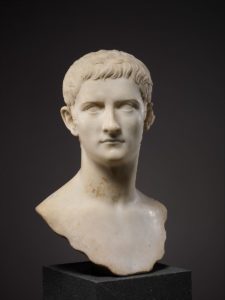
On page 90 of Calígula, José Manuel Roldán speaks of Livia, ‘the richest woman in Rome and also the most influential’. According to the legislation enacted by Augustus, she enjoyed full freedom to administer her property without the need for male guardianship. On the same page the author mentions Alexander Lysimachus, a Jewish potentate, brother of Philo of Alexandria. If we remember that, centuries later, wealthy women and Jews would play a central role in the empowerment of Judeo-Christianity, it is clear that I am repulsed by Imperial Rome insofar as in Republican Rome women had no such power and neither did Jews (see this tough article from the book On Beth’s Cute Tits). Studying the causes of the decline and fall of the Roman Empire sheds light on the Western world today, which reminds me of Hegel’s phrase ‘History only teaches us that man learns nothing from history.’
But we must still try to tell the story as it happened. On a footnote on page 211 Roldán tells us that there is no historical basis for ‘the revolting scene in I, Claudius, the novel by R. Graves—and, subsequently, in the television series based on it—that presents Caligula as the murderer of his sister in a fatal game in which, disguised as Jupiter, he opens Drusilla’s womb to eat the child inside her.’
It is most unfortunate that, in today’s prolefeed for the proles, the Roman era is presented through Hollywood as exclusively that of the Caesars, concealing centuries of Republican Rome. Now we complain about the culture of cancellation, but such a culture was started by Augustus.
On pages 153-154 of Calígula Roldán tells us that from Augustus onwards the burning of books began as a result of new censorship laws, and that this policy of repression was reinforced by Tiberius. Naturally, Roman intellectuals complained. Aulus Cremutius Cordus wrote a History of the Civil Wars of Rome which was burned by senatorial order because it praised Caesar’s assassins, Brutus and Cassius. (Those who have read William Pierce’s Who We Are will guess that those who killed Caesar to defend the Republic were the good guys and Julius Caesar, the perpetrator of a veritable holocaust of nordish Gauls, the bad guy.) A few centuries later, Constantine and subsequent Christian emperors took advantage of the culture of cancellation, initiated by the early Caesars, to burn all criticism of Judeo-Christianity: which is why the triumph of the imperial church was so overwhelming.
In my posts on Friday last week and Monday this week, I linked to videotaped interviews with Richard Miller, a New Testament scholar. Since in the foreword to Neo-Christianity I mentioned Miller in an important paragraph, I felt compelled to order his super-scholarly book, which I hope to read as soon as it arrives. But even in the linked videos we can see that Miller, along with other NT scholars, has been trying to understand these early Christian writings from the point of view of the 1st century Gentile world (as opposed to the studies of the fundamentalist schools which approach the NT solely from the POV of 1st century Judaism). Miller studied the deifications in the classical world. A passage from Roldán’s book about one of the deifications contextualises the deification that the evangelists would make a few decades later (but this time deifying a Jew).
The inordinate and gratuitous honours that Caligula decreed in memorial of Drusilla not only represented to public opinion—and, especially, to the senatorial order—the devotion bordering on the madness of a bereaved brother. Divinisation, whether it was a matter of innocent comedy or was indeed felt in all its theological dimension, had hitherto been an extraordinarily restrictive honour, only granted to two personages, Caesar and Augustus, whom, moreover, the popular imagination had already endowed with superhuman traits. [my translation]
Let us remember that by this time the Romans were no longer as purely Aryan as they had once been. This imperial devotion to the monarch (monarchy was forbidden in the Roman Republic) would also be suffered by the Russians in later centuries, who, historically, have been able to tolerate tyrants. I find it incredible that, in the beautiful streets of St. Petersburg, small busts with effigies of Lenin and Stalin are still sold to tourists! Like the Romans of imperial times, since the Mongol invasions* Russians haven’t been as genetically pure as they were before the Asian invasions.
________
(*) Bear in mind that Mongol terror ruled Russians for a quarter of a millennium, enough to spoil their Aryan blood due to interbreeding (see The Fair Race, pages 268ff).
4 replies on “Caligula, 4”
It is nice to see you type such words as “a culture of cancellation” – a lengthier version of the actual term “cancel culture”. There is something to be said about putting forward a distanced view from this madness (a different language helps, too).
I view it as a mistake to talk of “Mongol terror”, as first, the Golden Horde was mostly involved in taxation, second, it mainly consisted of mongrelised Turks, not Mongols proper, and third, it is my impression that the mongrelisation of Russians occurred due to Christian empire-building following their expansion downstream the Volga.
Regarding the emperor-worship – isn’t it similar to the Führerprinzip?
The Tatar confederation was eventually incorporated into the Mongol Empire when Genghis Khan unified the various steppe tribes. Historically, the Führerprinzip was a very brief thing. There is no equivalent in Germany of what I said above about St. Petersburg (imagine buying little busts of Hitler and Himmler on the streets of Munich for tourists).
Are you praising the Germans for not having busts of Hitler everywhere? I thought it was a great time when every school hanged a portrait of Hitler in the class room? Yes, idolatrous, pagan, Asiatic, call it whatever you like.
I am responding to what you said above, not praising the Germans for not having busts of Hitler everywhere.